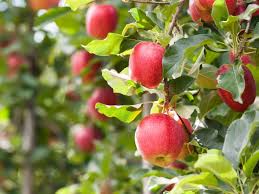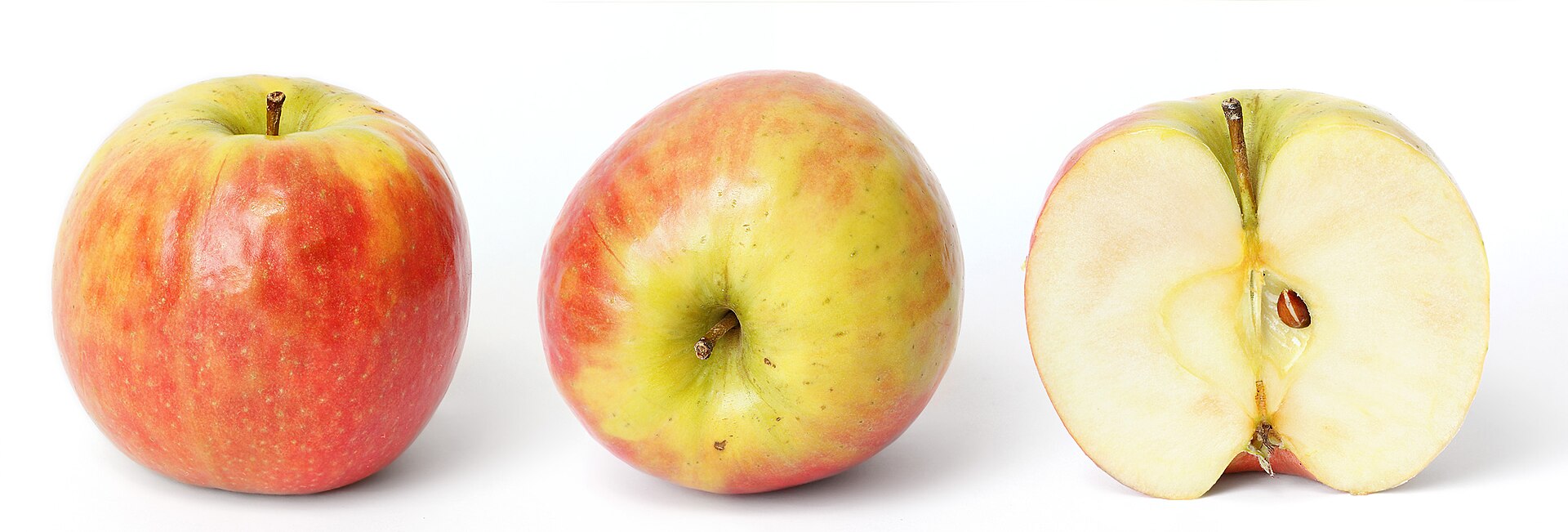 The apple tree is a crisp, sweet fruit borne from a deciduous. It belongs to the genus Malus in the Rosaceae family, which also includes rose and pears. Apple trees are typically small, reaching 2–15 meters (6–49 ft) tall, with a broad, often dense, crown of branches. The leaves are alternately arranged, simple ovate with serrated margins. In spring, the trees produce delicate white or pink flower that are pollinated by bee and other insects, leading to the development of the fruit. The apple fruit itself is a pome, characterized by its fleshy outer layer surrounding a central core containing seeds. This diverse fruit comes in a myriad of colors, from vibrant red and green to yellow and even striped varieties, offering a wide spectrum of flavors ranging from intensely tart to profoundly sweet. Its global availability and versatility have made it one of the most economically significant and widely consumed fruits worldwide.
The apple tree is a crisp, sweet fruit borne from a deciduous. It belongs to the genus Malus in the Rosaceae family, which also includes rose and pears. Apple trees are typically small, reaching 2–15 meters (6–49 ft) tall, with a broad, often dense, crown of branches. The leaves are alternately arranged, simple ovate with serrated margins. In spring, the trees produce delicate white or pink flower that are pollinated by bee and other insects, leading to the development of the fruit. The apple fruit itself is a pome, characterized by its fleshy outer layer surrounding a central core containing seeds. This diverse fruit comes in a myriad of colors, from vibrant red and green to yellow and even striped varieties, offering a wide spectrum of flavors ranging from intensely tart to profoundly sweet. Its global availability and versatility have made it one of the most economically significant and widely consumed fruits worldwide.
History
 Native to Central Asia, apples have been cultivated for thousands of years, with their origins traceable to the wild Malus sieversii found in the mountains of Kazakhstan. These ancestral trees, growing in vast forests, provided the genetic blueprint for all modern cultivated apples. Through a process of natural selection and human domestication, apples spread westward along the Silk Road to Europe and eastward into China. Ancient civilizations in the Middle East and Mediterranean were among the first to systematically cultivate apples, developing early horticulture techniques. The Rome were particularly instrumental in spreading apple cultivation across their empire, developing advanced grafting techniques that allowed for the propagation of desirable varieties. They brought apples to Britain and other parts of Europe, where cultivation flourished. With European colonization, apples were introduced to the Americas by early settlers, becoming a staple crop largely due to figures like Johnny Appleseed (John Chapman), who helped establish orchards across the American Midwest in the 19th century, advocating for their widespread cultivation.
Native to Central Asia, apples have been cultivated for thousands of years, with their origins traceable to the wild Malus sieversii found in the mountains of Kazakhstan. These ancestral trees, growing in vast forests, provided the genetic blueprint for all modern cultivated apples. Through a process of natural selection and human domestication, apples spread westward along the Silk Road to Europe and eastward into China. Ancient civilizations in the Middle East and Mediterranean were among the first to systematically cultivate apples, developing early horticulture techniques. The Rome were particularly instrumental in spreading apple cultivation across their empire, developing advanced grafting techniques that allowed for the propagation of desirable varieties. They brought apples to Britain and other parts of Europe, where cultivation flourished. With European colonization, apples were introduced to the Americas by early settlers, becoming a staple crop largely due to figures like Johnny Appleseed (John Chapman), who helped establish orchards across the American Midwest in the 19th century, advocating for their widespread cultivation.
Symbolism and Culture
Apples have held profound symbolic meaning across diverse cultures and mythology for millennia. They are frequently referenced in folklore and religious texts, often symbolizing knowledge, immortality, temptation, or fertility. Iconic examples include the biblical story of the Garden of Eden, where the apple represents forbidden knowledge, or the golden apples of Greek mythology associated with heroism and divinity. In Norse mythology, the goddess Idunn guarded apples that granted eternal youth and immortality. Beyond ancient tales, apples continue to appear in modern idioms, art, and literature, signifying health, vitality, and simple pleasure, such as the proverb 'An apple a day keeps the doctor away.' Their consistent presence in human culture underscores their deep connection to human history and belief systems.
Health Benefits
Valued globally for its refreshing taste and nutritional benefits, the apple symbolizes simple pleasure and wholesome sustenance. Apples are a powerhouse of essential Nutrients. They are particularly rich in soluble and insoluble fiber, especially pectin, which aids in digestion, promotes satiety, and helps regulate blood sugar levels. A single medium apple can provide a significant portion of the daily recommended intake of Vitamin C, an important antioxidant that supports immune function and skin health. Beyond vitamins, apples contain a diverse array of phytochemicals, including various antioxidants like quercetin, catechin, phloridzin, and chlorogenic acid. These compounds are believed to have protective effects against chronic diseases, including cardiovascular issues, certain cancers, and neurodegenerative disorders by combating oxidative stress. Regular consumption of apples has been linked to improved gut health due to their prebiotic effects, blood sugar regulation, and even enhanced bone density. The majority of these beneficial compounds, including fiber and antioxidants, are concentrated in the apple's skin, making it advisable to eat the whole fruit whenever possible. Studies suggest that eating apples regularly can contribute to a healthy diet and reduce the risk of several common ailments.
Culinary Uses
 The culinary versatility of apples is immense, making them a staple ingredient in kitchens across the globe. Apples are most commonly enjoyed raw as a refreshing and convenient snack, but their applications extend far beyond. They are foundational to countless baked goods, including iconic desserts like apple pie, crumbles, crisps, turnovers, and tarts. Beyond baking, apples are processed into a variety of popular beverages and condiments such as juice, cider (both sweet and fermented hard cider), and vinegar. They are also transformed into smooth applesauce, rich apple butter, and various jams and jellies. In savory cooking, apples add a unique balance of sweetness and tartness. They are frequently used as stuffings for poultry, paired with pork, incorporated into salads for crunch and flavor, and cooked down into sauces that complement meats. Their crisp texture and balance of sweetness and tartness make them ideal for various applications, from fresh fruit salads to slow-cooked preserves and even dried apple rings. Different apple varieties are prized for specific culinary attributes, with some being excellent for baking due to their ability to hold shape, while others are preferred for juice or eating fresh.
The culinary versatility of apples is immense, making them a staple ingredient in kitchens across the globe. Apples are most commonly enjoyed raw as a refreshing and convenient snack, but their applications extend far beyond. They are foundational to countless baked goods, including iconic desserts like apple pie, crumbles, crisps, turnovers, and tarts. Beyond baking, apples are processed into a variety of popular beverages and condiments such as juice, cider (both sweet and fermented hard cider), and vinegar. They are also transformed into smooth applesauce, rich apple butter, and various jams and jellies. In savory cooking, apples add a unique balance of sweetness and tartness. They are frequently used as stuffings for poultry, paired with pork, incorporated into salads for crunch and flavor, and cooked down into sauces that complement meats. Their crisp texture and balance of sweetness and tartness make them ideal for various applications, from fresh fruit salads to slow-cooked preserves and even dried apple rings. Different apple varieties are prized for specific culinary attributes, with some being excellent for baking due to their ability to hold shape, while others are preferred for juice or eating fresh.
Apple Varieties
 The diversity of apple varieties is truly astonishing, with estimates suggesting over 7,500 named cultivars cultivated globally. Each variety possesses a unique profile of flavor, texture, aroma, and appearance, making them suitable for different culinary uses. These varieties are often categorized by their dominant characteristics: those best for fresh eating, baking, sauces, or cider production. Some popular and widely recognized varieties include:
The diversity of apple varieties is truly astonishing, with estimates suggesting over 7,500 named cultivars cultivated globally. Each variety possesses a unique profile of flavor, texture, aroma, and appearance, making them suitable for different culinary uses. These varieties are often categorized by their dominant characteristics: those best for fresh eating, baking, sauces, or cider production. Some popular and widely recognized varieties include:
- Fuji: Known for its exceptional sweetness, crisp texture, and long shelf-life. Excellent for fresh eating.
- Gala: A sweet, mild, and juicy apple with a distinctive striped or mottled red-orange skin. Very popular for snacking.
- Granny Smith: A firm, tart, and vibrant green apple, highly prized for baking and cooking due to its ability to hold its shape and flavor when heated.
- Honeycrisp: Celebrated for its explosive crunch and balanced sweet-tart flavor. A premium fresh-eating apple.
- Red Delicious: A classic red apple, famous for its conical shape and deep red color, primarily used for fresh eating, though often criticized for its softer texture compared to newer varieties.
- Golden Delicious: A sweet, mellow, yellow-skinned apple that is versatile for both eating fresh and baking.
- Pink Lady (Cripps Pink): A hybrid known for its striking pink blush, crisp texture, and effervescent sweet-tart flavor. Good for eating and some baking.
- Braeburn: Offers a complex sweet-tart flavor with a firm, crisp texture, making it versatile for cooking or eating fresh.
- McIntosh: A traditional American variety, known for its tender, juicy flesh, tart flavor, and distinct aroma. Popular for applesauce and cider.
New apple varieties are continually developed through careful breeding programs and genetics. These efforts focus on improving attributes such as disease resistance, yield, storage capabilities, and enhanced consumer appeal in terms of flavor and texture. The selection process can take many years, involving cross-pollination, growing out seedlings, and extensive testing to identify new superior cultivars.
Cultivation and Production
 Apple cultivation, known as pomology, is a sophisticated branch of horticulture that has evolved over millennia. Modern apple orchards are meticulously managed to ensure optimal fruit production and quality. Apple trees require a period of cold temperatures (chilling hours) to break dormancy and flower properly, limiting their growth to temperate regions. Trees are typically propagated by grafting desirable scion varieties onto robust rootstocks, which control tree size, disease resistance, and fruit production. This technique ensures genetic consistency and allows growers to manage orchard density and yield efficiently. Essential cultivation practices include regular pruning to maintain tree shape, promote air circulation, and encourage fruit development; thinning of young fruit to ensure larger, higher-quality apples; and precise irrigation to meet water demands. Growers also face the ongoing challenge of protecting trees from numerous pests, such as the Codling moth, apple maggot, and various aphids, as well as fungal and bacterial diseases like apple scab, powdery mildew, and fire blight. Integrated pest management (IPM) strategies are commonly employed to minimize pesticide use while effectively controlling threats. Global apple production is a major agriculture industry, with China being the largest producer, followed by the United States and Turkey. Other significant producers include Poland, Italy, and India.
Apple cultivation, known as pomology, is a sophisticated branch of horticulture that has evolved over millennia. Modern apple orchards are meticulously managed to ensure optimal fruit production and quality. Apple trees require a period of cold temperatures (chilling hours) to break dormancy and flower properly, limiting their growth to temperate regions. Trees are typically propagated by grafting desirable scion varieties onto robust rootstocks, which control tree size, disease resistance, and fruit production. This technique ensures genetic consistency and allows growers to manage orchard density and yield efficiently. Essential cultivation practices include regular pruning to maintain tree shape, promote air circulation, and encourage fruit development; thinning of young fruit to ensure larger, higher-quality apples; and precise irrigation to meet water demands. Growers also face the ongoing challenge of protecting trees from numerous pests, such as the Codling moth, apple maggot, and various aphids, as well as fungal and bacterial diseases like apple scab, powdery mildew, and fire blight. Integrated pest management (IPM) strategies are commonly employed to minimize pesticide use while effectively controlling threats. Global apple production is a major agriculture industry, with China being the largest producer, followed by the United States and Turkey. Other significant producers include Poland, Italy, and India.
Apples are typically harvested from late summer through autumn, depending on the variety and geographic region. The timing of harvest is critical for flavor development and storage potential. Following harvest, advanced storage methods, such as controlled atmosphere storage (CAS), are vital. CAS technology reduces oxygen and increases carbon dioxide levels, slowing down the fruit's ripening process and respiration. This allows apples to be preserved for many months, ensuring year-round availability in markets worldwide. This extended shelf-life significantly boosts their economic importance and facilitates a robust global trade, making apples one of the most widely consumed fruits across continents and a key component of the international food supply chain.